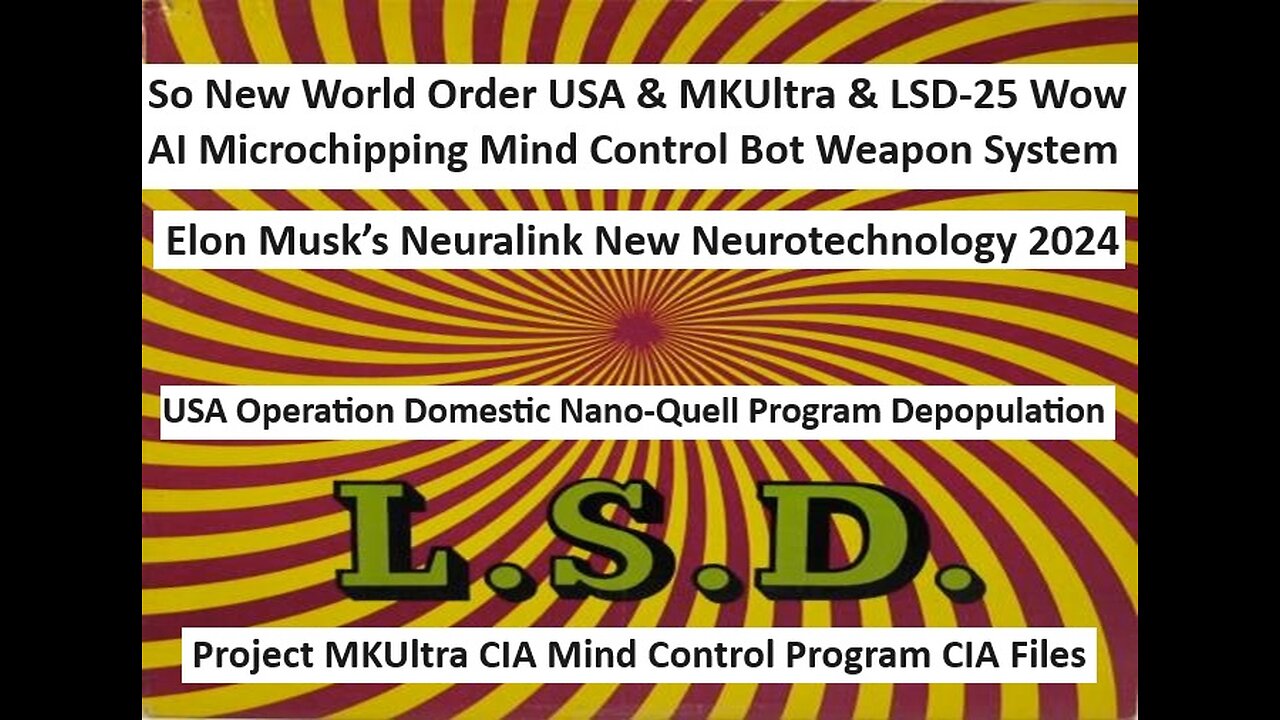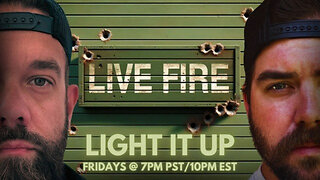Premium Only Content

New World Order USA & MKUltra & LSD-25 AI Microchipping Weapon Systems
So New World Order USA & MKUltra & LSD-25 AI Microchipping Mind Control Nano Bot Weapon Systems. Cultures have been using psychedelics for thousands of years to explore altered states of consciousness. It's amazing how science often comes up with the same ideas tribal cultures have held since the beginning of History.
Plus Top 100 Insane Classified Secrets They The US Government Didn't Want You To Know... See Links: Below In The Text... Thank You From New World Order !
Psychedelics are great. Funny story, LSD actually saved my life, I was going down the wrong path in my youth, alcohol, drugs, crime etc. One day a friend convinced me to try some acid, it was very potent, after getting over the giggles, I realized that my perception of everything completely changed, I saw life in a more logical sense, I literally looked into the mirror and I immediately saw the stupidity of my behavior, when I watched TV, I was able to see how extremely stupid it is, you actually see the subliminal messages in commercials, amazing! It changed my life for the better... Looking forward to tryout the psilocybin mushrooms next just don't know where or how to get them, so rare in my area.
It's illegal because it worked in more ways than one and "they" don't want people to figure out. Since it's illegal it can only be used by enthusiasts instead of the everyday person. Lysergic Acid Diethylamide is the best thing that ever happened to me and I too feel like I was called by it.
The more people talk about these kinds of drugs(like LSD or DMT), the more I want to try them. However, I'm wary of the health effects. I've heard somewhere that LSD has the ability to decay a human brain if taken in too big of doses. Although at the same time, I don't remember where I heard this, or if it's true. I implore everyone to do their research.
Trust me, it's never worth doing it, i was diagnosed with meningitis and often had seizures as a baby, but its symptoms has slowly been cured as i grew older... but when i got on to college i tried hallucinogenic drugs, and those seizures that i thought was never gonna happen returned. Most of the times i woke-up dizzy and numb, there are even times when something move, even if it's just a curtain swing i often assume there are people behind it, thinking of simple objects as silhouettes of person staring at me, i got anxious and fell to depression, fearing unknown things that my mind makes... even up until now my brain makes up scenarios i don't want to think of, yet it still keep on repeating in my head, even though I've never used any hallucinogenic drugs for more than 6 years.
OPERATION DOMESTIC NANO-QUELL
Operation Domestic Nano-Quell is a covert program allegedly run by the United States Department of Defense (DoD) to infect the US population with nanotechnology, which can be used to control or kill individuals with a signal. The program is reportedly designed to microchip the American people and beyond.
Evidence and Testimonies
Several documents and testimonies have been leaked online, claiming to reveal the existence of Operation Domestic Nano-Quell. These include:
A 2003 document titled “Nano Domestic Quell Program Depopulation 2003” which discusses the program’s goals and protocols.
A 2021 document titled “Full text of ‘Nano Domestic Quell Dossier’” which provides estimates for the program’s Phase 4 and discusses the infection rates of the US population.
A 2023 testimony on a leaked declassified document that the DoD has run an operation to infect the US population with nanotechnology.
A 2023 document titled “Nano Domestic Quell Testimony on a leaked declassified document that the Department of Defense has run an operation to infect the US population with nanotechnology which can be used to control or kill a person with a signal”.
Goals and Protocols
The alleged goals of Operation Domestic Nano-Quell include:
Microchipping the American people and beyond
Controlling or killing individuals with a signal
Dispersing nanotechnology through various mediums, including food, water, and air
Achieving a high infection rate of the US population, with estimates ranging from 87.2% to 99%
Concerns and Controversies
The existence and goals of Operation Domestic Nano-Quell have raised significant concerns and controversies, with many questioning the ethics and legality of such a program. Some have also raised concerns about the potential health risks and consequences of nanotechnology on human health.
Conclusion
While the existence of Operation Domestic Nano-Quell has not been officially confirmed by the US government, the leaked documents and testimonies suggest that such a program may be underway. Further investigation and verification are needed to confirm the accuracy of these claims and to address the concerns and controversies surrounding this alleged program.
chrome-extension://efaidnbmnnnibpcajpcglclefindmkaj/https://www.nano.gov/sites/default/files/pub_resource/dod-report_to_congress_final_1mar10.pdf
CIA's TOP SECRET Mind Control Drug
The CIA’s TOP SECRET Mind Control Drug, also known as MK-Ultra, was a secret human mind control program launched by the Central Intelligence Agency (CIA) in the 1950s. The program aimed to develop techniques to control human behavior, including the use of drugs, hypnosis, and other methods to alter human behavior.
The Program’s Origins
The CIA’s interest in mind control began during the Cold War, when the agency believed that the Soviet Union was using mind control techniques on American prisoners of war. In response, the CIA launched Project MK-Ultra, which was approved by CIA Director Allen Dulles on April 13, 1953.
The Program’s Goals
The program’s primary goal was to develop a “truth drug” that could be used to extract information from suspected Soviet spies during interrogations. Additionally, the CIA aimed to explore other possibilities of mind control, including the ability to manipulate foreign leaders and create a “perfect truth drug” for use in interrogations.
The Program’s Methods
The CIA used a variety of methods to achieve its goals, including:
Drugs: The CIA experimented with various drugs, including LSD, to alter human behavior and create a “mind control” effect.
Hypnosis: The agency used hypnosis to induce a state of deep relaxation, making subjects more susceptible to suggestion.
Psychic driving: Researchers used a combination of drugs and sound waves to create a state of deep relaxation, allowing them to implant suggestions in subjects’ minds.
Electroconvulsive therapy: The CIA used electroconvulsive therapy to alter brain function and create a state of amnesia.
The Program’s Controversies
The CIA’s MK-Ultra program has been widely criticized for its unethical and inhumane treatment of human subjects. Many of the experiments were conducted on unwitting subjects, including prisoners, mental patients, and even children. The program’s secrecy and lack of oversight led to widespread abuse and human rights violations.
The Program’s Legacy
The CIA’s TOP SECRET Mind Control Drug program was officially shut down in the 1970s, but its legacy continues to be felt today. The program’s methods and techniques have been widely condemned, and many of the researchers involved have been criticized for their actions. The program’s secrecy and lack of transparency have also led to ongoing controversy and debate about the CIA’s involvement in mind control experiments.
Key Takeaways
The CIA’s TOP SECRET Mind Control Drug, also known as MK-Ultra, was a secret human mind control program launched in the 1950s.
The program aimed to develop techniques to control human behavior, including the use of drugs, hypnosis, and other methods.
The program was criticized for its unethical and inhumane treatment of human subjects, including prisoners, mental patients, and children.
The program was officially shut down in the 1970s, but its legacy continues to be felt today.
CIA launches mind control program, April 13, 1953 On this day in 1953, Allen Dulles, the director of the CIA, ordered the agency to develop mind-controlling drugs to be deployed against members of the Soviet bloc. The ultrasecret program was purportedly launched in response to Soviet, Chinese, and North Korean use of mind control techniques on U.S. prisoners of war during the Korean War.
The CIA sought to use similar methods on its own captives. At the height of the Cold War, the project also attempted to produce an effective truth drug for interrogating suspected Soviet spies and to explore other possibilities of mind control. Moreover, the agency wanted to be able to manipulate foreign leaders using such techniques. It launched, for example, several failed schemes to drug Fidel Castro.
The CIA’s Office of Scientific Intelligence organized the project, code-named Project MKUltra, in coordination with the U.S. Army Biological Warfare Laboratories. In some cases, academic researchers were funded through grants funneled to them from CIA front organizations while remaining unaware that the CIA sought to use their work for its own purposes. In other instances, however, top officials at these institutions knew about the CIA’s role.
The agency often sponsored experiments without the subjects’ knowledge or consent. The experiments sought to identify and develop drugs and procedures to weaken interrogation subjects and force confessions through mind control. They involved surreptitious administration of drugs — especially LSD — and other chemicals, hypnosis, sensory deprivation, isolation, and verbal and sexual abuse.
Some 80 institutions, including colleges and universities, hospitals, prisons, and pharmaceutical companies participated in the research program. In all, about 150 separate experimental investigations were carried out.
The operation was reduced in scope in 1964, further curtailed in 1967 and halted in 1973. A 1973 order by CIA Director Richard Helms to destroy all the project’s files hampered subsequent oversight work, conducted both on Capitol Hill and within the executive branch.
The public first learned about the project in 1975 through disclosures by the Senate Select Committee to Study Governmental Operations with Respect to Intelligence Activities, chaired by Sen. Frank Church (D-Idaho). The Senate panel reported that “drugs were used primarily as an aid to interrogations, but … materials were also used for harassment, discrediting, or disabling purposes.”
At about the same time, President Gerald Ford set up a reform-minded commission to study CIA activities within the United States, headed by Vice President Nelson Rockefeller.
In 1977, a Freedom of Information Act request uncovered a cache of 20,000 documents relating to project, which led to further Senate hearings later that year. Some surviving documents were declassified in July 2001. In December 2018, a trove of newly declassified documents included a letter to an unidentified doctor discussing work on six dogs made to run, turn and stop via remote control and brain implants.
https://www.todayifoundout.com/index.php/2013/09/one-shocking-cia-programs-time-project-mkultra/
Operation midnight climax
Operation Midnight Climax was a secret CIA program that ran from 1955 to 1965, as a sub-project of the larger MKUltra mind-control research program. The operation was established by Sidney Gottlieb, a chemist and spymaster, and was initially placed under the direction of the Federal Bureau of Narcotics in Boston.
The Program’s Purpose
The primary goal of Operation Midnight Climax was to test the effects of LSD and other drugs on unsuspecting individuals, often using sex workers to lure men into a safe house in San Francisco. The CIA agents would then observe the men’s behavior under the influence of the drugs, often using a two-way mirror and bugging equipment.
The Safe Houses
The operation had several safe houses in San Francisco, including one on Telegraph Hill, where CIA agents would observe the men’s behavior from a hidden room. The safe houses were equipped with bugging equipment, two-way mirrors, and even a portable toilet, where agents like George White would sit and observe the proceedings while enjoying a martini.
The Participants
The participants in Operation Midnight Climax were often unsuspecting men who were lured to the safe houses by sex workers. The men were given LSD or other drugs, and their behavior was observed and recorded by CIA agents. The operation also involved the use of prostitutes, who were paid in part with chits that could be used for favors such as getting out of jail.
The Legacy
Operation Midnight Climax was shut down in 1965, but its legacy continues to be felt today. The program’s use of LSD and other drugs on unsuspecting individuals raises ethical concerns, and its secrecy and lack of transparency have led to ongoing controversy and debate.
Key Figures
Sidney Gottlieb: The chemist and spymaster who established Operation Midnight Climax as a sub-project of MKUltra.
George White: A CIA agent who ran the operation and was known for his enthusiasm for the program.
Ike Feldman: A CIA agent who worked under George White and described him as a “son of a bitch, but he was a great cop.”
Timeline
1955: Operation Midnight Climax begins in San Francisco.
1962: The operation is scaled back following a report by CIA Inspector General John Earman.
1965: Operation Midnight Climax is shut down.
1972: The MKUltra program is officially shut down.
References
A brief weird history of brainwashing
Operation Midnight Climax (2002)
The CIA’s Operation ‘Midnight Climax’ Is Exactly What It Sounds Like
Operation Midnight Climax
When the CIA ran a LSD sex-house in San Francisco
https://www.history.com/mkultra-operation-midnight-climax-cia-lsd-experiments
The CIA's Appalling Human Experiments With Mind Control ON APRIL 10, 1953, ALLEN DULLES, THE NEWLY APPOINTED DIRECTOR OF THE CIA, delivered a speech to a gathering of Princeton alumni. Though the event was mundane, global tensions were running high. The Korean War was coming to an end, and earlier that week, The New York Times had published a startling story asserting that American POWs returning from the country may have been “converted” by “Communist brain-washers.”
Some GI’s were confessing to war crimes, like carrying out germ warfare against the Communists–a charge the U.S. categorically denied. Others were reportedly so brainwashed that they had refused to return to the United States at all. As if that weren’t enough, the U.S. was weeks away from secretly sponsoring the overthrow of a democratically elected leader in Iran.
Dulles had just become the first civilian director of an agency growing more powerful by the day, and the speech provided an early glimpse into his priorities for the CIA. “In the past few years we have become accustomed to hearing much about the battle for men’s minds–the war of ideologies,” he told the attendees. “I wonder, however, whether we clearly perceive the magnitude of the problem, whether we realize how sinister the battle for men’s minds has become in Soviet hands,” he continued. “We might call it, in its new form, ‘brain warfare.’”
Dulles proceeded to describe the “Soviet brain perversion techniques” as effective, but “abhorrent” and “nefarious.” He gestured to the American POWs returning from Korea, shells of the men they once were, parroting the Communist propaganda they had heard cycled for weeks on end. He expressed fears and uncertainty–were they using chemical agents? Hypnosis? Something else entirely? “We in the West,” the CIA Director conceded, “are somewhat handicapped in brain warfare.” This sort of non-consensual experiment, even on one’s enemies, was antithetical to American values, Dulles insisted, as well as antithetical to what should be human values.
Fear of brainwashing and a new breed of “brain warfare” terrified and fascinated the American public throughout the 1950s, spurred both by the words of the CIA and the stories of “brainwashed” G.I.’s returning from China, Korea, and the Soviet Union. Newspaper headlines like “New Evils Seen in Brainwashing” and “Brainwashing vs. Western Psychiatry” offered sensational accounts of new mind-control techniques and technologies that no man could fully resist. The paranoia began to drift into American culture, with books like The Manchurian Candidate and The Naked Lunch playing on themes of unhinged scientists and vast political conspiracies.
The idea of brainwashing also provided many Americans with a compelling, almost comforting, explanation for communism’s swift rise–that Soviets used the tools of brainwashing not just on enemy combatants, but on their own people. Why else would so many countries be embracing such an obviously backward ideology? American freedom of the mind versus Soviet “mind control” became a dividing line as stark as the Iron Curtain.
MK-ULTRA
Three days after his speech decrying Soviet tactics, Dulles approved the beginning of MK-Ultra, a top-secret CIA program for “covert use of biological and chemical materials.” “American values” made for good rhetoric, but Dulles had far grander plans for the agency’s Cold War agenda.
MK-Ultra’s “mind control” experiments generally centered around behavior modification via electro-shock therapy, hypnosis, polygraphs, radiation, and a variety of drugs, toxins, and chemicals. These experiments relied on a range of test subjects: some who freely volunteered, some who volunteered under coercion, and some who had absolutely no idea they were involved in a sweeping defense research program. From mentally-impaired boys at a state school, to American soldiers, to “sexual psychopaths” at a state hospital, MK-Ultra’s programs often preyed on the most vulnerable members of society. The CIA considered prisoners especially good subjects, as they were willing to give consent in exchange for extra recreation time or commuted sentences.
Whitey Bulger, a former organized crime boss, wrote of his experience as an inmate test subject in MK-Ultra. “Eight convicts in a panic and paranoid state,” Bulger said of the 1957 tests at the Atlanta penitentiary where he was serving time. “Total loss of appetite. Hallucinating. The room would change shape. Hours of paranoia and feeling violent. We experienced horrible periods of living nightmares and even blood coming out of the walls. Guys turning to skeletons in front of me. I saw a camera change into the head of a dog. I felt like I was going insane.”
Bulger claimed he had been injected with LSD. Lysergic acid diethylamide, or acid, had become one of the CIA’s key interests for its “brain warfare” program, as the agency theorized it could be useful in interrogations. In the late 1940s, the CIA received reports that the Soviet Union had engaged in “intensive efforts to produce LSD,” and that the Soviets had attempted to purchase the world’s supply of the chemical. One CIA officer described the agency as “literally terrified” of the Soviets’ LSD program, largely because of the lack of knowledge about the drug in the United States. “[This] was the one material that we had ever been able to locate that really had potential fantastic possibilities if used wrongly,” the officer testified.
With the advent of MK-Ultra, the government’s interest in LSD shifted from a defensive to an offensive orientation. Agency officials noted that LSD could be potentially useful in “[gaining] control of bodies whether they were willing or not.” The CIA envisioned applications that ranged from removing people from Europe in the case of a Soviet attack to enabling assassinations of enemy leaders. On November 18, 1953, a group of ten scientists met at a cabin located deep in the forests of Maryland. After extended discussions, the participants agreed that to truly understand the value of the drug, “an unwitting experiment would be desirable.”
The CIA remained keenly aware of how the public would react to any discovery of MK-Ultra; even if they believed these programs to be essential to national security, they must remain a tightly guarded secret. How would the CIA possibly explain dosing unassuming Americans with LSD? “Precautions must be taken not only to protect operations from exposure to enemy forces but also to conceal these activities from the American public in general,” wrote the CIA’s Inspector General in 1957. “The knowledge that the Agency is engaging in unethical and illicit activities would have serious repercussions in political and diplomatic circles and would be detrimental to the accomplishment of its mission.”
OPERATION MIDNIGHT CLIMAX
The CIA’s initial experiments with LSD were fairly simple, if shockingly unethical. The agency generally dosed single targets, finding volunteers when they could, sometimes slipping the drug into the drinks of fellow CIA employees. Over time these LSD experiments grew increasingly elaborate. Perhaps the most notorious of these projects was Operation Midnight Climax.
In 1955, on 225 Chestnut Street, San Francisco, the CIA was devoting substantial attention to decorating a bedroom. George White oversaw the interior renovations. Not much of a decorator, White had a storied career in the Federal Bureau of Narcotics. When the CIA moved into drug experiments, bringing White on board became a top priority.
White hung up pictures of French can-can dancers and flowers. He draped lush red bedroom curtains over the windows. He framed a series of Toulouse-Lautrec posters with black silk mats. For a middle-aged drug bureaucrat, each item evoked sex and glamour.
George White wasn’t building a normal bedroom, he was building a trap.
White then hired a Berkeley engineering student to install bugging equipment and a two-way mirror. White sat behind the mirror, martini in hand, and waited for the action to begin. Prostitutes would lure unsuspecting johns to the bedroom, where the men would be dosed with LSD and their actions observed by White from beyond the mirror. As payment for their services the sex workers receive small amounts of cash, as well as a guarantee from White that he’d intercede when the women inevitably had run-ins with law enforcement in the future.
Though the CIA piloted these safe houses as a stage for testing the effects of LSD, White’s interest shifted to another element of his observations: the sex. The San Francisco house became the center of what one writer called “the CIA carnal operations,” as officials began asking new questions about how to work with prostitutes, how they could be trained, and how they would handle state secrets. The agency also analyzed when in the course of a sexual encounter information could best be extracted from a source, eventually concluding that it was immediately after sex.
But perhaps unsurprisingly, much of White’s actions were driven by pure voyeurism: “I toiled wholeheartedly in the vineyards because it was fun, fun, fun,” White later said. “Where else could a red-blooded American boy lie, kill, cheat, steal, rape, and pillage with the sanction and blessing of the All-Highest?"
THE DEMISE OF MK-ULTRA
The CIA’s experiments with LSD persisted until 1963 before coming to a fairly anticlimactic end. In the spring of 1963, John Vance, a member of the CIA Inspector General’s staff, learned about the project’s “surreptitious administration to unwitting nonvoluntary human subjects.” Though the MK-Ultra directors tried to convince the CIA’s independent audit board that the research should continue, the Inspector General insisted the agency follow new research ethics guidelines and bring all the programs on non-consenting volunteers to an end.
In 1977, Senator Edward Kennedy oversaw congressional hearings investigating the effects of MK-Ultra. Congress brought in a roster of ex-CIA employees for questioning, interrogating them about who oversaw these programs, how participants were identified, and if any of these programs had been continued. The Hearings turned over a number of disturbing details, particularly about the 1953 suicide of Dr. Frank Olson, an Army scientist who jumped out of a hotel window several days after unwittingly consuming a drink spiked with LSD. Amid growing criminalization of drug users, and just a few years after President Nixon declared drug abuse as “public enemy number one,” the ironies of the U.S.’s troubling experimentation with drugs appeared in sharp relief.
But throughout the hearings, Congress kept hitting roadblocks: CIA staffers claimed they “couldn’t remember” details about many of the human experimentation projects, or even the number of people involved. The obvious next step would be to consult the records, but that presented a small problem: in 1973, amid mounting inquiries, the director of MK-Ultra told workers “it would be a good idea if [the MK-Ultra] files were destroyed.” Citing vague concerns about the privacy and “embarrassment” of participants, the men who crafted MK-Ultra effectively eradicated the paper record for one of the United States’ most obviously illegal undertakings. A program born in secrecy would hold onto many of its secrets forever.
Elon Musk’s Neuralink is a neurotechnology
Elon Musk’s Neuralink is a neurotechnology company that has been developing implantable brain-computer interfaces (BCIs) to enable people to control devices with their minds. Founded in 2016, Neuralink aims to achieve a symbiosis between humans and machines by creating a direct interface between the brain and computers.
Key Features:
Brain-Computer Interfaces (BCIs): Neuralink’s technology allows for the direct communication between the brain and computers, enabling people to control devices with their thoughts.
Neural Implants: The company has developed implantable devices that can read and write neural signals, allowing for the transmission of information between the brain and computers.
Neuroprosthetics: Neuralink’s technology has the potential to restore motor function in individuals with paralysis or other motor disorders.
Recent Developments:
First Human Implant: In January 2024, Neuralink successfully implanted a device in a human subject, Noland Arbaugh, who was paralyzed from the neck down. The implant allowed Arbaugh to control a computer mouse with his thoughts.
FDA Approval: The US Food and Drug Administration (FDA) has approved Neuralink’s device for a second human trial, following the successful implantation of the first device.
Advancements: Neuralink has made significant advancements in the development of its technology, including the ability to read and write neural signals, and the creation of a neural implant that can be implanted in the brain.
Potential Applications:
Neuroprosthetics: Neuralink’s technology has the potential to restore motor function in individuals with paralysis or other motor disorders.
Brain-Computer Interfaces: The company’s technology could enable people to control devices with their minds, revolutionizing the way we interact with technology.
Neurological Disorders: Neuralink’s technology could potentially treat neurological disorders such as Parkinson’s disease, epilepsy, and depression.
Conclusion:
Elon Musk’s Neuralink is a neurotechnology company that is pushing the boundaries of brain-computer interfaces and neuroprosthetics. With its recent advancements and FDA approval, Neuralink is poised to revolutionize the way we interact with technology and potentially treat neurological disorders.
Elon Musk NET LINK
Elon Musk’s Neuralink is a neurotechnology company that aims to integrate the human brain with computers. The company’s primary goal is to develop a high-bandwidth brain-machine interface (BMI) that enables seamless communication between the human brain and computers.
Key Developments:
Brain-Computer Interface (BCI): Neuralink has developed a BCI system that uses tiny electrodes to read and write neural signals. This technology has been tested in animals, including monkeys, and has shown promising results.
Neural Threads: Neuralink has developed a technology called “neural threads” that use thin, flexible electrodes to read and write neural signals. These threads can be inserted into the brain and can potentially be used to control devices or restore motor function in paralyzed individuals.
Human Trials: Neuralink has begun testing its technology in humans, with the goal of eventually implanting devices in paralyzed individuals to enable them to control devices or communicate with others.
Potential Applications: Neuralink’s technology has the potential to revolutionize the treatment of paralysis, depression, and other neurological disorders. It could also enable humans to control devices with their minds, potentially leading to new forms of communication and interaction.
Notable Quotes:
“A monkey has been able to control a computer with its brain.” - Elon Musk
“It’s like a Fitbit in your skull with tiny wires.” - Elon Musk
“We’re just not as smart as we could be because the data link between the information we can get from our phones to our brains isn’t as fast as it could be.” - Elon Musk
Timeline:
2016: Neuralink was founded by Elon Musk and a team of scientists and engineers.
2017: Neuralink announced its plans to develop a brain-machine interface technology.
2019: Neuralink demonstrated its technology in a presentation, showing off its neural threads and brain-computer interface.
2020: Neuralink began testing its technology in humans, with the goal of eventually implanting devices in paralyzed individuals.
Conclusion:
Elon Musk’s Neuralink is a revolutionary technology that has the potential to change the way we interact with the world. With its brain-machine interface technology, Neuralink aims to enable seamless communication between the human brain and computers, potentially leading to new forms of communication, interaction, and treatment for neurological disorders.
1966: Timothy Leary’s “spoken word” LP on LSD.
In 1966, Timothy Leary, a renowned psychologist and counterculture icon, released a spoken-word LP on LSD, titled “LSD” or “The Psychedelic Experience”. This album was a comprehensive guide to the use of LSD, featuring Leary’s narration and insights on the drug’s effects, benefits, and potential uses.
Content and Structure
The album is a two-sided record, with Leary’s spoken words on one side and a short review of LSD-25 on the other. The first side features Leary’s narration, where he answers frequently asked questions about LSD, including its effects, uses, and potential risks. He also discusses the five levels of consciousness-expansion, sexual visions, and the importance of “set and setting” when using the drug.
Significance and Legacy
Leary’s “spoken word” LP on LSD was a significant contribution to the counterculture movement of the 1960s, as it provided a comprehensive and authoritative guide to the use of LSD. The album was widely popular among the psychedelic community and helped to popularize the drug among the youth of the time.
Trivia
The album was released in 1966, a time when LSD was still legal in the United States.
Leary’s LP was one of the first spoken-word albums to focus on the topic of LSD and its effects.
The album’s cover art features a psychedelic design, reflecting the era’s fascination with the drug and its cultural significance.
Overall, Timothy Leary’s “spoken word” LP on LSD is a historical artifact of the 1960s counterculture movement, offering a unique glimpse into the era’s fascination with psychedelics and the cultural revolution that ensued.
On rear cover: A short review of LSD-25, followed by:
Here are some of the more freqently askded questions.
How should psychedelic drugs be used?
What are the 5 levels of consciousness-expansion? What are the sexual visions of LSD?
Are set and settings important?
What are the psychedelic drugs?
Should anyone be allowed to take LSD?
How long does the drug last?
Does LSD cause hallucinations?
Is LSD habit-forming?
What effects does the drug have?
Do psychedelic drugs pose a danger?
Does LSD cause insanity?
Are there substitutes being sold as LSD?
https://youtu.be/35AQI53v4CY?si=oBVt2jjGskiG8w4v
The questions are not assigned to one of both sides.
https://pophistorydig.com/topics/timothy-leary-1960s/
These secrets will shock you! For this list, we'll be looking at deep, dark government secrets that were declassified or leaked to the public. Our countdown of insane classified secrets they don't want you to know includes secrets from WWI, WWII, the Cold War, the Space Shuttle Challenger disaster, and more!
Top 100 Insane Classified Secrets They Didn't Want You To Know
Welcome to New World Order and today we’re counting down our picks for the Top 100 Insane Classified Secrets They Didn't Want You To Know. For this list, we’ll be looking at deep, dark government secrets that were declassified or leaked to the public. We’ll be laying them out in the order that the events in question occurred, regardless of when they were made public. Where do you stand on government transparency? How about whistleblowers? Let us know in the comments.
#100: In 1917, during World War I, the German government sent a secret diplomatic message to the government of Mexico, proposing a military alliance if the U.S. declared war on Germany. Known as the Zimmerman Telegram after German Foreign Secretary Arthur Zimmermann, it was intercepted and decrypted by British intelligence.
#99: In 2011, the CIA made public its six oldest classified documents, dating from 1918. Included are formulas for secret ink and techniques for opening sealed envelopes without leaving a trace.
#98: In the The Tuskegee Syphilis Study from 1932-72, the United States Public Health Service (PHS) and CDC studied 400 Black men with syphilis. Wanting to observe the long-term effects, they didn’t inform the men of their diagnosis, or treat them, and over a quarter died. The study ended when a whistleblower within the PHS went to the press.
#97: In 1933, 6,700 Russian prisoners were sent to Nazino Island in Siberia and told they were to cultivate the island and build a settlement. In reality, they were abandoned with almost no supplies, leading to violence and cannibalism. The Nazino Tragedy saw around 4,000 die of murder, starvation, and disease.
#96: In 1936, Imperial Japan created a secret unit, Manshu Detachment 731, to research biological and chemical weapons. They conducted deadly human experiments and horrific war crimes in China, killing an estimated 200,000-300,000 people. At the end of WWII, the US gave captured researchers immunity in exchange for data.
#95: In Project Pigeon, which ran from 1943-44, American behaviorist B. F. Skinner was contracted by the U.S. military to train a unit of pigeons that could guide missiles from inside them. Another program around the same time, dreamed up by a dental surgeon, looked into using bats as bombers.
#94: During World War II, the Allies secretly housed their top codebreakers at the remote estate Bletchley Park in Buckinghamshire, England. The infamous Enigma and Lorenz ciphers were broken there.
#93: The Second World War saw the British Security Service MI5 create the Double-Cross System, capturing Nazi spies and flipping them into double agents who sent disinformation back to Berlin.
#92: Large swaths of Great Britain served as test grounds for germ warfare experiments by the British Ministry of Defense. From 1940-79, potentially dangerous chemicals and micro-organisms were released into local populations without their knowledge.
#91: From 1941-45, American and British intelligence agencies enabled the escape of Allied POWs with the help of the United States Playing Card Company. They embedded detailed escape maps between layers of playing cards and sent them in Christmas packages to prison camps throughout Europe.
#90: Declassified documents from 1942 reveal that British Prime Minister Winston Churchill had no intention of putting Adolf Hitler on trial after the war. Instead, he argued for summary execution of all top Nazis.
#89: Future cooking star Julia Child attempted to join the military during World War II but was rejected because of her height. In 1942, she was instead recruited into the Office of Strategic Services, where she helped create shark repellant to protect explosive devices and downed pilots.
#88: 29 Navajo men were recruited as Code Talkers by the U.S. Marines during World War II. They created a code based on the unwritten Navajo language that allowed them to keep important military secrets from the Japanese.
#87: From 1942-46, a team of military officers and physicists embarked on arguably the most significant R&D program in history: the Manhattan Project. It created the first nuclear bombs and changed the world forever.
#86: In 1944 and 1946, the U.S. army and a defense contractor dumped over 37 million gallons of radioactive waste from atomic bomb testing in shallow wells in Tonawanda near Buffalo, New York.
#85: Requested by British Prime Minister Winston Churchill after the end of World War II in 1945, Operation Unthinkable was a set of military plans in case of war with the USSR. One of the two plans envisioned a surprise attack with U.S. aid. The other prepared for a Soviet invasion of Scandinavia and U.S. withdrawal from Europe.
#84: It took some time after Germany’s surrender in 1945 for the Allies to find evidence of Hitler’s demise. Allied Intelligence thought it possible that the German dictator may have escaped, so the FBI launched a secret investigation into his whereabouts.
#83: In Operation Paperclip, which lasted from 1945-59, the U.S. recruited over 1,600 German scientists and engineers, many of whom had been members of the Nazi Party. They played a major role in the U.S. space program.
#82: After the Soviet style East German secret police, the Stasi, disbanded in 1990, it was revealed that they’d spent decades conducting covert surveillance on civilians, amassing a trove of intelligence and blackmail files.
#81: In 1950’s Operation Sea-Spray, the US Navy sprayed bacteria over the Bay Area in order to study San Francisco’s vulnerability to biological agents. While they deemed the bacteria harmless, it was correlated with an outbreak of infections that may or may not have been related.
#80: Project Artichoke, the precursor to MKUltra, was a 1951 CIA program researching interrogation and mind control methods. They tested drug cocktails, hypnosis, forced addiction, and LSD.
#79: After fighting the “Thousand Mile War” when Imperial Japan invaded the Aleutian Islands, the U.S. prepared contingencies for a Soviet paratrooper invasion of Alaska. In Operation Washtub from 1951-59, Alaskan fishermen and trappers were trained as spies to keep tabs on Soviet movements at sea.
#78: The Church Committee of 1975 revealed a number of government secrets. One was the CIA’s heart attack gun: a weapon from the 1950s that shot untraceable poison projectiles that would give a victim a heart attack without any physical evidence.
#77: In Operation Ajax, also known as Operation Boot, the CIA and MI6 orchestrated a coup against progressive Iranian Prime Minister Mohammad Mosaddegh in 1953. Mosaddegh had led a movement to nationalize Iran’s oil industry. U.S.- backed Shah Mohammad Reza Pahlavi took power, until being overthrown by Ayatollah Khomeini in the Iranian Revolution of 1979.
#76: The long-term effects of radiation were unknown in the aftermath of World War II. The U.S. government enacted Project SUNSHINE in 1953-58, stealing the remains or parts of deceased children from around the world for tissue tests. Parents were not informed.
#75: From 1953-73, the CIA studied possible uses of psychotropic drugs in interrogation, torture, and mind control through Project MKUltra. While some participants volunteered willingly, many were experimented upon without their consent.
#74: The mid 20th century saw the CIA facilitating the replacement of democratically elected leaders in foreign countries with right wing dictators. In 1954’s Operation PBSuccess, they organized a coup against Guatemalan President Jacobo Árbenz to aid the United Fruit Company, resulting in decades of atrocities.
#73: In the 1950s, the U.S. military had a secret program to develop circular fighter jets, aka flying saucers, called Project 1794. The goal was to develop a fleet of supersonic planes that could easily take out Soviet bombers.
#72: From 1956-71, the FBI infiltrated virtually every major organization bent on changing American society, part of a program called COINTELPRO. They went after socialists, civil rights organizations and leaders like MLK, Vietnam protesters, the Black power movement, and far-right groups like the KKK.
#71: Project Gladio, which ran from 1956-90, involved NATO creating secret ‘stay-behind’ paramilitary organizations across Europe, in case of Soviet invasion.
#70: In Operation LAC (Large Area Coverage) in 1957 and 1958, zinc cadmium sulfide was sprayed over large sections of the U.S. and Canada to track dispersal patterns.
#69: To undermine Indonesian President Sukarno, the CIA created an adult film in 1958 starring a Sukarno lookalike or an actor wearing a mask. The Soviets had already taped Sukarno cavorting with operatives posing as flight attendants in Moscow. But the delighted Sukarno had just asked for more copies. Ultimately the CIA didn’t release their film, pursuing other covert operations until Indonesian General Suharto seized power.
#68: During the Cold War, the CIA distributed over 10 million copies of banned books and magazines inside the Soviet Union. Books like Boris Pasternak’s “Doctor Zhivago” were spread to undermine the government.
#67: In 1959’s Project Horizon, the Army, Navy, and Air Force joined forces to study the feasibility of a military research base on the moon.
#66: Lunik and Sputnik were the crown jewels of the early Soviet satellite program. Unbeknownst to the Soviet Union, the CIA managed to steal, study, and return the Lunik from an exhibition in 1959.
#65: The U.S.’s CORONA Spy Satellites managed to take photos of the Middle East and China between 1959 and 1972. Now declassified, the images are used by archaeologists, who can track changes over time to important historical sites.
#64: The Greenbrier luxury resort in West Virginia is the site of a massive underground bunker built in 1959 named "Project Greek Island "that was meant to serve as an emergency shelter for Congress during the Cold War. However, it was decommissioned after The Washington Post blew the lid in 1992.
#63: Francis Gary Powers, a pilot of the secret U-2 spy plane, was shot down and captured deep inside the Soviet Union in 1960. At first, American authorities said it had been a weather aircraft, but had to admit the truth just a few days later.
#62: In 1959, Cuban revolutionary Fidel Castro overthrew U.S.-backed dictator Fulgencio Batista and assumed power. The CIA tried to assassinate the communist leader hundreds of times. Many of the failures were so public that the Church Committee acknowledged eight that occurred between 1960 and 65.
#61: Acoustic Kitty was an aptly named CIA project in the 1960s that involved implanting microphones into the ears of cats, who were to spy on the Soviets. Unfortunately, the CIA found it difficult to train the cats, wasting millions of dollars on the attempt.
#60: Codenamed HERO, Oleg Penkovsky was a Soviet colonel and double agent for both MI6 and the CIA. It was Penkovsky’s key intel that clued the United States into the presence of Soviet missiles in Cuba. Without that knowledge, they would likely have been successfully deployed. The Soviets cottoned on and executed him in 1963.
#59: In the early 1960s, the U.S. built a nuclear-powered research facility in Greenland, called Camp Century. While it was not secret, it was part of a secret program - Project Iceworm, which aimed to dig 2,500 miles of tunnels beneath the tundra, allowing the military to secretly deploy nuclear missiles.
#58: Authorized by JFK in 1961, Operation Mongoose was a secret CIA campaign of sabotage and terrorism in Cuba. The intent was to destabilize and depose the Cuban government.
#57: In a far-fetched plan to overthrow Cuban leader Fidel Castro in 1962, Department of Defense special operations expert Edward Lansdale suggested firing star shells from a submarine over Havana on All Souls’ Day to stir “Cuban superstitions”.
#56: Operation Northwoods was a scrapped Department of Defense plan in 1962 for the CIA to conduct false-flag attacks against American military and civilian targets, in order to justify an invasion of Cuba. It was rejected by JFK.
#55: President Kennedy, furious with a series of government leaks, greenlit a CIA program called Project Mockingbird in 1962 to wiretap and spy on American journalists.
#54: In Project AQUILINE from 1965-71, the CIA attempted to create a fleet of small, bird-sized, nuclear-powered, remote-controlled aircraft. They could be used for spying or dropping covert packages to operatives in the field. The project was eventually scrapped.
#53: Through the Indian ‘Health’ Services in the 1960s and 70s, the U.S. government sterilized up to 70,000 Native American women, often through coercion or without their knowledge.
#52: Ayatollah Khomeini overthrew the U.S.-backed Shah of Iran in 1979. Declassified documents reveal that he’d secretly tried to negotiate the transition with both the Kennedy and Carter Administrations.
#51: While conducting covert maneuvers in the Gulf of Tonkin in August 1964, a U.S. destroyer came under attack. President Johnson used dubious reports of a second attack two days later as justification for deploying U.S. troops in Vietnam. But this second attack never happened. In 2005, the NSA admitted that it had skewed its intelligence report to Johnson.
#50: Operation CHASE or “Cut Holes And Sink ‘Em” was a D.O.D. program from 1964-72 carried out by the U.S. Navy. For the better part of a decade, unused surplus munitions were loaded onto empty ships and scuttled around 250 miles off the American coast. On four occasions, chemical weapons were disposed of as a part of Operation CHASE.
#49: In an attempt to spy on the Chinese nuclear program, the U.S. and India worked together to install sensors powered by plutonium in the Himalayas in 1965. Unfortunately, the mission was abandoned amidst bad weather, and the plutonium was lost. Locals accuse both governments of having inadvertently melted mountain snow with the sensors, causing deadly floods.
#48: In the mid-1960s, Indonesian General Suharto oversaw the mass murder of between 500,000 to 1.2 million people. The U.S. was complicit in the killings, framed as a anti-communist ‘purge’, even providing names to Suharto’s death squads. With Western backing, Suharto became President.
#47: In 1957, the Soviets had deployed new, effective surface-to-air missiles, known as S-75s. The CIA disguised ‘SAM Sniffer’ drones as U-2 planes, to collect data on the missiles as they were shot down. This strategy finally succeeded in 1966 over Vietnam; the data collected led to the development of a warning system.
#46: In 2010, United States Army soldier Chelsea Manning leaked 250,000 diplomatic cables to Wikileaks. Dating from 1966 on, the cables contained unflattering assessments of world leaders, and revealed that the U.S. and Britain had spied on the UN in the lead up to their invasion of Iraq in 2003.
#45: In 1967, during the Six-Day War between Israel and a coalition of Arab states, the Israeli Air Force and Navy accidentally attacked the USS Liberty. The spy ship was badly damaged, with 171 crew members wounded and 34 killed.
#44: The CIA looked into a scientist’s method for guiding lighting onto targets using artificial leaders in 1967, but the program was scrapped as less practical than conventional weapons.
#43: From 1967-72, the Air Force ran a covert cloud seeding project called Operation Popeye in Vietnam as an attempt to extend the monsoon season. Its intention was to disrupt North Vietnamese supply chains.
#42: 40 years after the fact, the NSA declassified documents concerning Project MINARET, a secret surveillance program in the 1960s and 70s. During the Vietnam War, the NSA had wiretapped anti-war activists, civil rights leaders, journalists, and two U.S. Senators.
#41: Operation CHAOS was another domestic espionage project during the Vietnam War years. Both Presidents Johnson and Nixon authorized surveillance of American citizens by the CIA, looking for foreign influence among left-wing movements.
#40: Fearing for his campaign, Republican presidential candidate Richard Nixon sabotaged peace talks between North and South Vietnam in 1968, promising South Vietnam a better deal once he was President. President Johnson’s declassified tapes reveal that he knew and considered Nixon’s actions “treason”. But he kept quiet rather than revealing FBI and NSA wiretaps.
#39: The U.S. Army maintained a base in Thule, Greenland, for much of the Cold War. One of their B-52s, armed with nuclear weapons, went down near the base in 1968. It was later revealed that the Army lied about its payload recovery: one nuclear bomb was never found.
#38: In 1968, American soldiers murdered hundreds of unarmed civilians, including children, in the small Vietnamese village of My Lai. At least 20 had also been sexually assaulted. A year later, photo journalist Ron Haeberle published photos of the event in a Cleveland newspaper, leading to global shock and outrage.
#37: In the wake of the My Lai massacre, the Pentagon created the Vietnam War Crimes Working Group to look into other American war crimes in Vietnam. They compiled a secret archive of documents alleging 320 incidents, including seven massacres.
#36: In Operation Condor, which ran from 1968-89, the U.S. backed a campaign of political repression, state terrorism, and coups in South America under right-wing dictatorships. Up to 60,000 people were killed. U.S. State Secretary Henry Kissinger was closely involved.
#35: 30 years after Apollo 11 landed on the moon in 1969, a historian discovered a contingency speech written by Nixon’s speechwriter, William Safire, which had been prepared in case the astronauts were stranded on the moon.
#34: A test rocket fired by the U.S. military in Utah, bound for New Mexico, went horribly off course in 1970. The rocket, containing radioactive isotopes that effectively made it a ‘salted bomb’, landed in Mexico’s Mapimi desert.
#33: The CIA took the term ‘surveillance bug’ literally in the early 1970s: they created a robotic dragonfly or ‘Insectothopter’ for eavesdropping. However, crosswinds rendered the device impractical.
#32: In a 25-year legal battle, journalist Jon Weiner wrested from the FBI documentation on federal efforts to investigate and surveil Beatle John Lennon. Fearing that Lennon’s anti-war activities could cost him re-election, Nixon had the Immigration and Naturalization Service issue a deportation order in 1972.
#31: In 1968, the Soviet submarine K-129 sank 1,600 miles northwest of Hawaii. After six years and the equivalent of $4.7 billion in modern terms, the CIA built an explorer to recover the ship. Project Azorian was the most expensive operation of the Cold War.
#30: Available within the FBIs archive of Freedom of Information Act materials, you can find the FBI file on Bigfoot from the late 1970s. They analyzed a hair sample, and concluded it came from a deer.
#29: We already mentioned the CIA’s role in Operation Condor. Well, we also now know that people who ‘disappeared’ from 1976-83 during the reign of Argentina's military dictatorship were assassinated. The efforts were so organized that the state assassination squads filed time cards and expense reports.
#28: In Project Constant Peg, a special squadron of U.S. fighter pilots trained on Soviet MiGs from 1977-88, in order to understand and develop combat tactics against them.
#27: In the late 1970s, CIA operatives in Moscow would use sex dolls, nicknamed jack-in-the-boxes, to give KGB tails the slip. While the view of KGB agents in the car behind them was obscured, operatives would jump out of their own car’s passenger seat, leaving the decoy to inflate in their place.
#26: The U.S. and U.S.S.R. had a psychic arms race throughout the Cold War. The U.S. Army created the Stargate Project, which ran from 1978-95, in an attempt to build a remote viewing psychic military unit.
#25: Robert Hanssen was a high level agent within the FBI with a long and storied career that spanned the 1980s and 90s. He was also one of the highest placed Soviet and Russian spies in American history.
#24: When the Soviet Union invaded Afghanistan, the CIA put together Operation Cyclone from 1979-92, funding and arming mujahideen Afghan fighters to resist the Russians.
#23: CIA agents compiled jokes overhead in the Soviet Union in the 1980s. They were part of an assessment of Soviet morale.
#22: A Soviet lieutenant colonel named Stanislav Petrov saved the world from nuclear holocaust in 1983. When a nuclear early-warning system reported incoming American missiles, he decided not to tell his superiors, believing (correctly as it turned out) that it was a false alarm. His superiors would likely have launched a retaliatory nuclear strike.
#21: An expedition finally located the wreck of the Titanic in September 1985. But the expedition’s primary purpose was actually a secret mission to map out the wreckage of two American nuclear powered submarines that sank in the 1960s.
#20: The American public was told that the astronauts aboard the ill-fated Space Shuttle Challenger, which exploded in 1986, had died instantly. We now know that they were quite possibly conscious until impact, 2 minutes and 45 seconds later.
#19: Started in 1992, the NSA program RAMPART-A sucks communication data right out of the fiber-optic cables that form the backbone of the internet. It was revealed in 2013 when former NSA contractor Edward Snowden leaked information about the mass surveillance programs of the Five Eyes intelligence alliance, comprising Australia, Canada, New Zealand, the U.K., and the U.S.
#18: A U.S. Air Force laboratory produced a proposal to build a psychochemical weapon in the mid-1990s. The intent was to release sex pheromones on enemy troops, making them attracted to each other.
#17: Spying between allies is generally considered bad form. But the NSA listened in on the phone calls of French officials, including at least three Presidents, according to top-secret documents released by Wikileaks in 2015. Other documents revealed that the NSA had also tapped German Chancellor Angela Merkel’s phone.
#16: In 2000, the Iranian military purchased a team of dolphins trained to attack boats from the Russians.
#15: Under the Bush administration, the CIA established torture sites around the world in the wake of 9/11, where detainees - some innocent - were beaten, waterboarded, and sexually assaulted. In 2002, memoranda known as the “Torture Memos” advised the CIA on techniques that could be considered legal. One was leaked to the press in 2004.
#14: The trove of documents leaked by U.S. soldier and whistleblower Chelsea Manning also included the Guantánamo Files, or Gitmo files. These documents revealed that more than 150 innocent farmers, chefs, and drivers, were held for years without charges inside Guantanamo Bay detention camp, established in 2002.
#13: Also leaked by Chelsea Manning, the Iraq War Logs included U.S. army field reports from 2004-09 that recorded 66,081 civilian deaths out of 109,000 recorded deaths. It represented the biggest leak in U.S. military history, larger even than the Afghan War documents, which had revealed the deaths of hundreds of civilians in unreported incidents.
#12: In a mid-2000s program called Devil Eyes, the CIA made figurines of Al-Qaeda leader Osama Bin Laden. When heated, the face peeled off to reveal a demonic visage. The intent was to distribute the doll in Afghanistan and Pakistan, but it’s unclear how many were actually shipped, if any.
#11: A former engineer for Apple claims that in 2005 the company created a classified iPod for the Department of Energy that doubled as a Geiger counter.
#10: From 2005-10, the U.S. and Israeli cyber intelligence services joined forces with Stuxnet, a virus sent to Iran to disrupt their nuclear program.
#9: In 2007, two American Apache helicopters carried out a series of air-to-ground attacks in Baghdad, Iraq. They received global attention in 2010 when Chelsea Manning released gunsight footage to Wikileaks that revealed the crew laughing as they killed several men, all civilians, including two Reuters journalists.
#8: Initiated in 2007, PRISM was another NSA program revealed by whistleblower Edward Snowden. It allows the NSA to collect communications matching court-approved search terms from companies like Microsoft, Yahoo, Google, Facebook, YouTube, and Apple.
#7: The Advanced Network Technologies department with the NSA has a classified catalog, the ANT catalog, listing hardware and software available for spy operations. A version written in 2008-09 was leaked and published by German magazine Der Spiegel in 2013.
#6: Since at least 2009, the FBI has had a civilian air force surveilling U.S. cities from above, registered under fake companies, according to a 2015 report by the Associated Press.
#5: Edward Snowden also revealed a program called Dishfire, run by the NSA and the U.K.’s GCHQ, that collects about 200 million text messages every day around the world. Another NSA program, MYSTIC, can record the metadata and content of phone calls from entire countries.
#4: In a series of documents dating back to 2013, and released as ‘Vault 7’, Wikileaks revealed CIA capabilities to compromise various devices and software, including cars, smart TVs, web browsers, and the operating systems of smartphones and computers.
#:3: U.S. Cyber Command launched Operation Glowing Symphony against ISIS in 2016. One of the largest cyber attacks in history on ISIS in 2016, it caused major disruption to the terrorist group.
#2: After they were leaked, the Pentagon formally released three recordings of UFOs taken by United States Navy fighter jets in 2004, 2014, and 2015.
#1: In 2022 and 2023, hundreds of classified foreign intelligence documents, primarily related to the Russo-Ukrainian War, were leaked on Discord. The culprit was allegedly 21-year old gamer and airman Jack Teixeira, of the Massachusetts Air National Guard.
-
 4:48
4:48
What If Everything You Were Taught Was A Lie?
18 days agoOpen Your Mind Wow... So Old Sayings Do Truly Have Meaning And An True Origin Story
3.73K4 -
 3:51:28
3:51:28
I_Came_With_Fire_Podcast
15 hours agoSPECIAL LIVE FIRE w/ Bearded Viking Mead Co
81.5K9 -
 1:28:52
1:28:52
Kim Iversen
13 hours agoUnmasking the Truth: Most Censored Historian On Past Election Meddling, COVID, and Trump
78.3K69 -
 2:10:00
2:10:00
TheSaltyCracker
11 hours agoNow Lefties Lose Bathroom War ReeEEeE Stream 11-20-24
148K383 -
 1:03:31
1:03:31
Fresh and Fit
13 hours agoWhy Men Need Options To Avoid Falling For This!
119K14 -
 1:26:56
1:26:56
Flyover Conservatives
1 day agoWar Raging, Bank Closing, and Humanoid Robots: It’s Biblical! - Clay Clark | FOC Show
55.8K21 -
 5:32:27
5:32:27
tacetmort3m
1 day ago🔴 LIVE - MY MOST ANTICIPATED GAME IS OUT - STALKER 2 LAUNCH DAY
29.1K -
 1:05:16
1:05:16
Glenn Greenwald
15 hours agoBiden Again Isolates The U.S. To Protect Israel; Will The Trump Admin Be Any Different On Israel? U.S. To Send Ukraine Civilian-Killing Landmines | SYSTEM UPDATE #369
104K110 -
 2:21:27
2:21:27
WeAreChange
14 hours agoPSYOPS Launched To Sabotage Trump's Cabinet! MAGA Fights Back!
63.7K11 -
 1:25:02
1:25:02
The Officer Tatum
14 hours agoLIVE The View FORCED To Apologize, Laken Riley Verdict, Nancy Mace and MORE OT Show EP 12
76.8K190